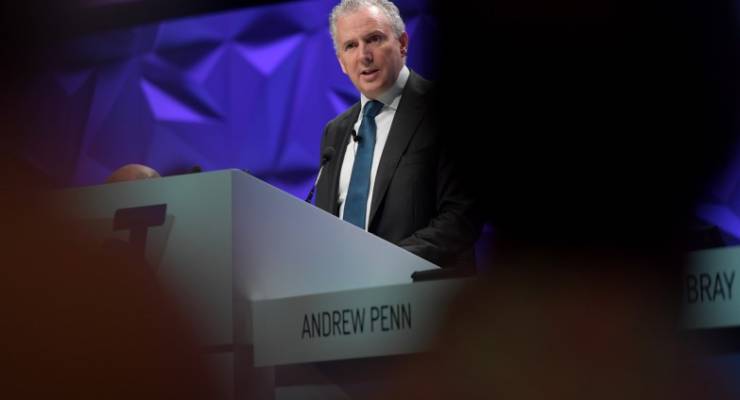
If there was any remaining doubt that the Australian telecommunications sector is caught in a perfect storm, Telstra CEO Andy Penn removed them at Telstra’s annual results briefings, warning of upheaval, disruption and an uncertain future for Australia’s most widely held listed company.
There are plenty of elements in the storm that the entire global telecoms industry is facing, but in Australia the federal government-funded National Broadband Network has accelerated the reckoning, ramping up competitive pressures across the entire sector.
But underpinning the changes roiling the industry is the imminent emergence of 5G mobile technology, continuing revenue erosion by over-the-top internet companies (such as Google, Facebook, WhatsApp and Skype) and the commoditisation of bespoke business services as cloud computing increasingly become an inextricable part of telecoms services.
Nowhere is all this being felt more keenly than at Telstra, Australia’s biggest telecoms company and the traditional fixed-line gorilla in the market that also holds the biggest market share in mobiles.
Now its mass-market fixed-line monopoly has been removed after it was forced to sell its copper and HFC networks into the NBN, leaving it open to competitors prepared to take smaller margins and who do not have dividends to protect, and more than $4 billion in capital expenditure each year to fund.
“When you flow it down to the bottom line, that’s more like 50% of the profit historically that Telstra has received is impacted by the implementation of the NBN,” Penn said at the results briefing in Melbourne yesterday.
As forecast at the emergency investor day that Penn held on June 22 to unveil a dramatic and, at least on paper, comprehensive overhaul of the company, Telstra’s $26 billion-a-year revenue flatlined and its earnings and profits fell: 5.9% and 8.8% respectively.
Also as forecast, dividends were trimmed once more, leaving the full year dividend at 22 cents per share, slashed from 31 cents the year before and no promises that it won’t fall further in the current financial year where, as Penn noted there will be more “challenges”, a 2-3% fall in the Australian mobile market, falling average customer revenues and restructuring costs. Ouch.
The Telstra chief — under pressure from markets as the share price has been more than halved, and dividends cut for the first time in the company’s history — continued to rail against the NBN.
“I do think that there are major structural problems with NBN pricing,” Penn said. “Wholesale prices have more than doubled … And they’re set to triple if the current model continues. And I just think that is unsustainable and it’s going to create the wrong sort of dynamics in the industry, and I think they have to structurally change, but that’s not a new comment from me.”
Perhaps, but it’s actually Telstra that has the most immediate structural headache. Until the June 22, Telstra2022 restructure plan was announced, Penn — and his predecessor David Thodey — continued to run Telstra on a cost base suited to a fixed network owner and operators collecting near monopoly margins.
This is despite the deal to sell off its ubiquitous copper network to the NBN — occurring five long years ago. So Telstra has increasingly been a reseller of NBN services for several years now. Sure, the government under-compensated Telstra with its $10 billion payment but management inaction has dramatically exacerbated the problem. And Telstra CFO Warwick Bray has been shown the door. The NBN is now more than 70% built with its 2020 finish now in sight — so more pain for Telstra (and Optus).
Only an hour after Penn’s doom and gloom, NBN CEO Bill Morrow demurred on any pricing issues, saying he didn’t see any problems and that NBN was “forcing a nation-wide churn event” — telecoms industry shorthand for customers shifting from one service provider to another — as he delivered a doubling of revenue in 12 months. He described this result, his last as CEO, as “fabulous”.
Asked if Telstra could ever return to its halcyon days of profits (and dividends), Penn could only say: “We believe we’ve got the right strategy, we believe we’re making the right investments, building the right capabilities.”
But he admitted that Telstra and the sector as a whole had failed, in the past, to take advantage of their position as the essential core of a networked, broadband-enabled world.
Whether he can reverse that trend is very much a wait-and-see game, but an accelerated, ruthless drive to restructure Telstra’s cost base should the first port in any industry storm, and his most urgent priority. Right now, the rest is just window dressing.








Firstly, we have all lost out due to the regrettable privatisation of Telstra. The short term need to satisfy shareholders with big dividends has inevitably skewed its investment strategy and long term planning.
Secondly, a previous management bungled its negotiations with the federal government leading to the creation of NBN Co, which was always going to spawn a new cohort of more ‘agile’ competitors.
Thirdly, successive CEO’s have tried but failed to address a chronically bureaucratic organisational structure…
http://theluckygeneral.biz/2018/07/30/is-telstra-simply-unmanageable-right-now/
I agree with the first and third points. The second point – more debatable. The NBN is a government monopoly, which has dictated terms to the market. Telstra and all their competitors are in the same boat; none of the telcos in Australia are currently making anything close to a profit by reselling NBN services to consumers, the largest market segment & greatest profit / revenue centre.
If (until?) the NBN pricing model fundamentally changes, then we may see a different story, but at the moment, Telstra, Optus and TPG will focus on building their 5g capability, while all other carriers will focus on setting themselves up to be acquired or, in the case of the ACCC getting cranky, focus on becoming failed entities.
I probably shouldn’t bother adding my voice to the others who have spent a lifetime in foaming rage at Telstra’s attitude towards its customers. There are undoubtedly millions of us, and the problem goes back to the days when Telstra was a government monopoly and all the way forward to today, when it’s not. Dealing with Telstra has always been like playing squash in a room stuffed with mattresses. If anyone ever cares they’re such a tiny cog in an infernal clockwork universe that they, in turn, find it impossible to help. To reward the shareholders the company cut staff, jacked their prices up and used a foreign call centre. The result is that the company has done badly and the shareholders have been screwed along with everybody else. Any mug could have told them where they were going wrong. I’ve told them repeatedly for many, many years, but of course they never listened. And I’m a shareholder. What a mug.
I’m not sure what your analysis tells you, but fundamentally, the problem is one of again trying to “create” a market where there is a natural monopoly. In this case the natural monopoly was the basic infrastructure of the telephone network, which until recently was a monopoly. You might have had a “competitor” from Optus’ network, but it was limited in its reach and functionality. The real competition could only come in the mobile space, but once again it would require competitors putting up their own radio towers thus duplicating facilities, unless spectrum was also split between them etc. By heroic contortions and jumping through hoops one might get “market competition” to work in favour of bringing prices down for the consumer, but there must be simpler ways to regulate a government monopoly to provide the required services at a decent cost. Of course these simpler ways are anathema to the neoliberal ideologues who infest every nook and cranny of our society now, having been brain-washed by years of reading propaganda from the “free press”, largely owned by Murdoch. So we now have the various multiple shemozzles delivering low quality internet, mobile, and other services, at exorbitant prices, and all continuously argued about by ignorant shock jocks paid for by the very same “free press” magnates. Enjoy!
I forgot: before talk anymore about 5G, please define what it is. In other words is there a technical specification available? You know actual specs. Thanks.
Basically 5G is a faster version of 4G. Wikipedia has an excellent description of the specs as they stand. As general rollout is imminent I imagine these specs are more or less it as companies must already be designing products that use the improved capabilities.
Ironically the future value is in fixed-line infrastructure with the demise of net-nuetrality. This is just what Telstra sold out of and they are going to get killed in the mobiles market by more customer friendly competitors. Those that say that NBN won’t be a valuable future item or should be written down, must be the same people who have never heard of a company called Netflix.
cant say I care about 5G, obviously it is technobabble for a faster service which doesnt concern me .
Coverage and reliability where I live in a rural area is still an issue.
The main problem with Telstra since privatisation is that the customer service is shocking and the only way i seem to be able to resolve issues is to contact the TIO ie ombudsman then it all happens quickly and Telstra offers you money to shut up.
Ringing the Phillipines which takes 3 hrs to resolve or using on line chat is a joke and Telstra has no credible email contact cos they dont really want to talk to you.